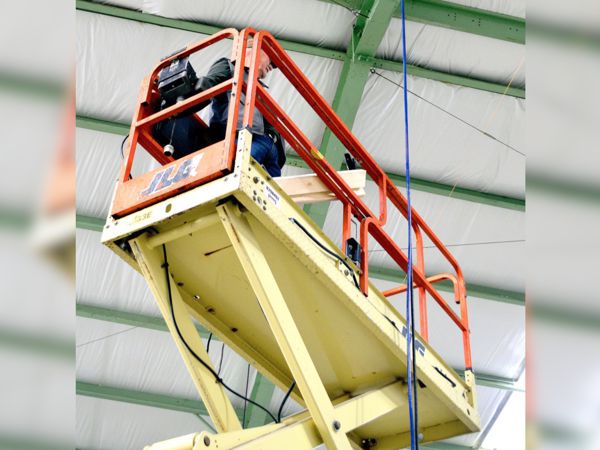Scissor lifts are a versatile and essential tool in many industries, providing a stable platform for workers to perform tasks at elevated heights. These lifts are commonly used in construction, retail, entertainment, and manufacturing, offering a safer and more efficient alternative to traditional scaffolding. Unlike aerial work platforms, scissor lifts use a unique "scissors" mechanism made of crossed beams that lift the platform vertically.
Due to their structural design, many scissor lifts fall under OSHA's scaffolding standards, which emphasize safety, proper maintenance, and operator training. Understanding the risks associated with these machines is crucial for ensuring safe operation.
The main hazards include falls from the platform and tip-overs. While rare, beam collapses can occur if the equipment isn't maintained or operated as recommended. It's vital for operators to follow manufacturer guidelines and schedule regular inspections.
Some of the most well-known manufacturers of scissor lifts today are JLG and Terex's Genie, both known for producing high-quality, reliable equipment that meets industry safety standards.
### Scissor Lift Design
A scissor lift is essentially a mobile scaffold that allows workers to reach higher areas. Most models can lift workers up to 25–50 feet, with platform sizes ranging from 24–36 inches deep and 48–72 inches wide. The number of people it can carry depends on the model’s weight capacity, so it's important to check specifications before use.
Operators can control the lift either from the base or from the platform itself. While this feature adds convenience, it also introduces risk—many manufacturers advise against moving the lift while it's extended to prevent accidents.

Source: OSHA
Notes: Scissor lifts get their name from the cross beams that resemble scissors, which raise and lower the platform.
### General Safety Measures
Before using a scissor lift, it's essential to evaluate the worksite and identify potential hazards. Operators must implement effective controls for fall protection, stabilization, and positioning. Only trained personnel should operate these machines.
### Fall Protection
To prevent falls, scissor lifts are equipped with guardrails around the platform. These rails help secure lanyards and harnesses, adding an extra layer of safety. Some models may have rope sections for rail access, requiring extra caution during use.
- Always check that the guardrail system is in place before working.
- Never stand on the guardrails; only use the platform.
- Keep all tools and materials within easy reach to avoid leaning over the edge.

Notes: Falling from the platform is one of the most common dangers. Workers should never stand on the railing and should always use a body harness when necessary.
### Stabilization
Stability is key to preventing tip-overs. Operators should ensure the ground is flat, firm, and level. Some models are designed for rough terrain, but even those have limitations. Moving the lift while it's raised is generally not recommended.
- Avoid moving the lift while it's elevated.
- Use scissor lifts outdoors only in good weather conditions. Wind speeds above 28 mph can be dangerous.
- Never exceed the load rating, as heavy loads increase the risk of collapse.
Scissor lifts can tip over if used on uneven ground, struck by a vehicle, or hit by an object while extended.


Notes: Tip-overs can happen if the lift is struck at the base or hits an object while extended. Always maintain a clear path and avoid obstacles.
### Positioning
Proper positioning helps prevent crushing and electrocution hazards. If the lift moves too close to a person or object, it could cause serious injury. Electrocution is also a risk if the lift comes into contact with power lines.
Operators should be aware of arc flash risks, where electricity can jump from a line to the lift or worker, even without direct contact.


Notes: Always be cautious when raising or lowering the platform and when moving the lift across the ground.
### Group Discussion Topics
- Is the scissor lift in good condition? Perform a daily visual inspection.
- Are there any nearby hazards like power lines or gas pipes?
- What is the condition of the floor surface?
- How many people will be on the platform, and does the combined weight meet the limit?
- What could cause the scissor lift to tip over?
### Find Similar Articles By Topic
#material handling
#construction
#toolbox talks
#scissor lifts
High-end refrigeration instrument testing equipment, source factory,High-end refrigeration instrument testing equipment, source factory, stock inventory, can accept customization and OEM service
Our company has always had strict quality control standards in the market of refrigeration and heat exchange equipment, focusing on providing customised services to our customers. Not only do we have high requirements for the selection of raw materials, but we also keep up to date with the latest production processes and have high testing standards.
Our company mainly produces products for:Fin Evaporator.Fin Type Condenser.Capillary Tube. Coolant Reservoir.Plate Reinforcement Parts.Stamped Parts. Aluminum Tube .Instrument Testing Equipment.
If you have any interest, please feel free to contact us. We can provide customized service according to your drawings or samples.
Instrument Testing Equipment,Precision Salt Mist Tester,Salt Spray Tester Tester,Adjustable Electric Heating Plate